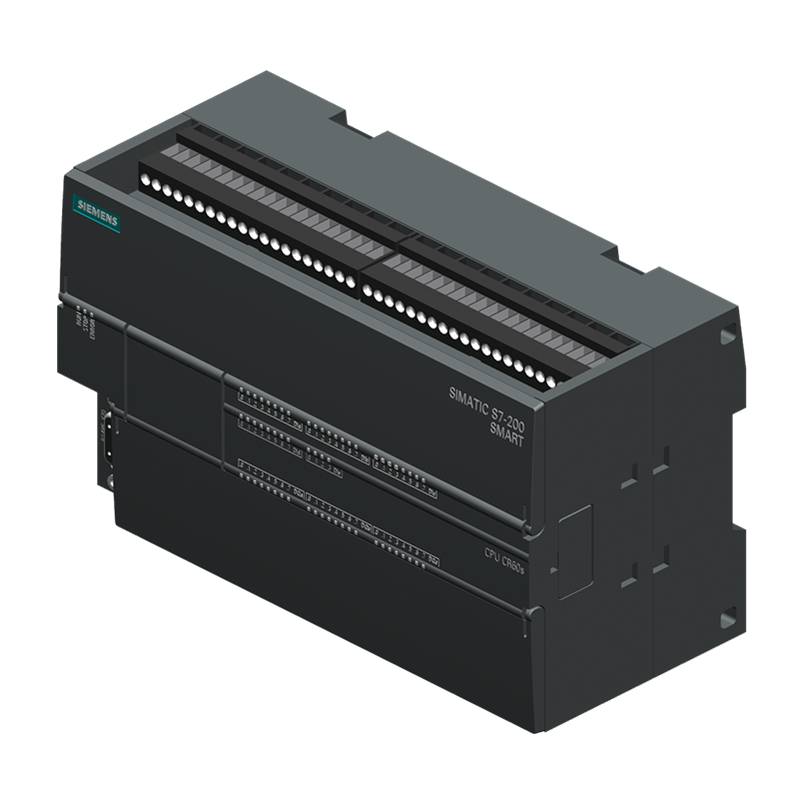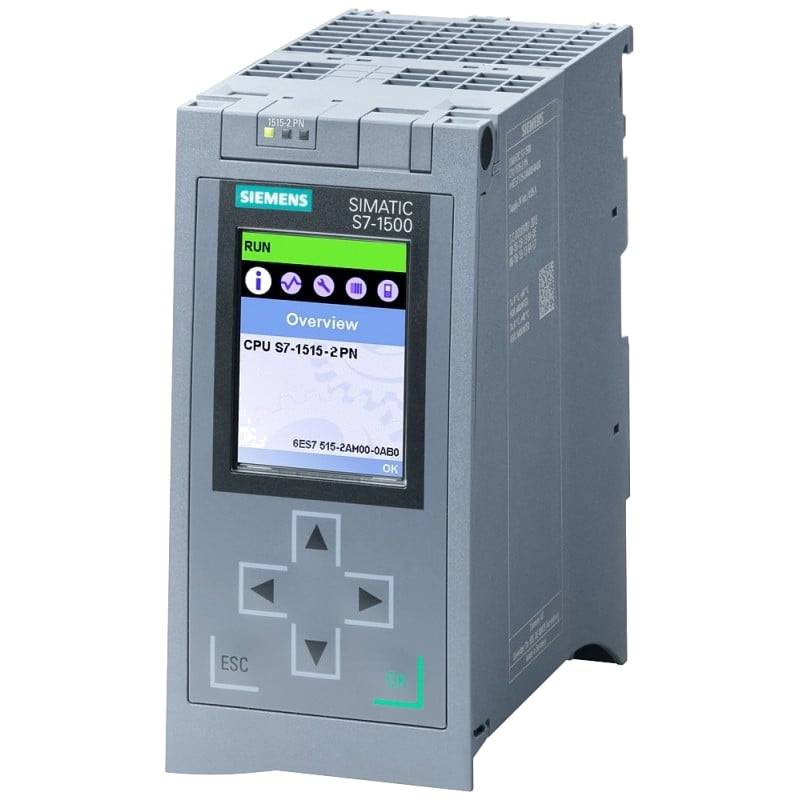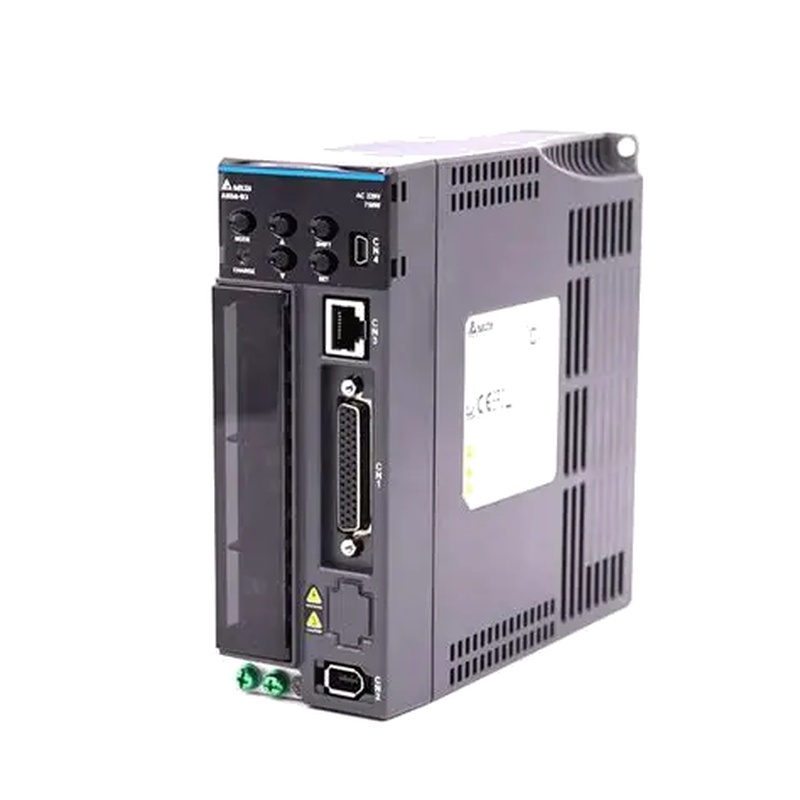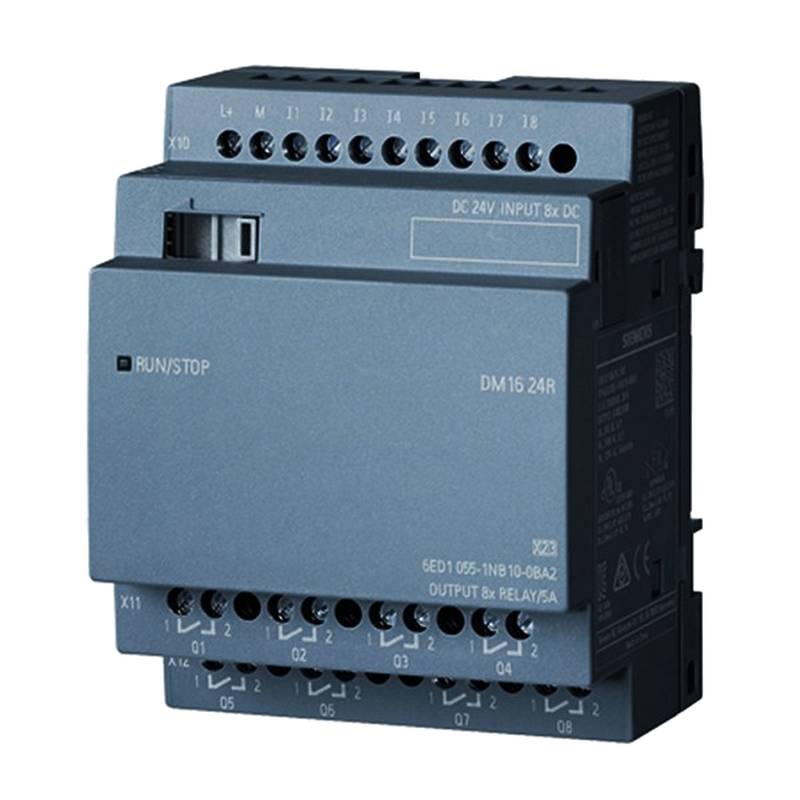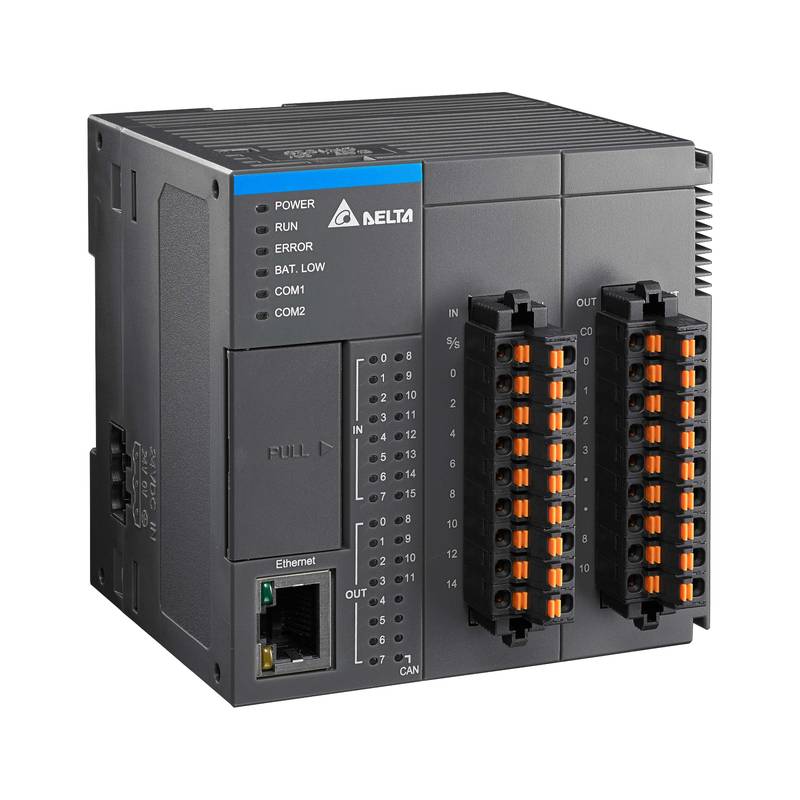
The Siemens 6ES7288-1CR60-0AA0 200 SMART Relay Output Module stands as a robust solution for expanding control capabilities in industrial automation, offering 64 high-capacity relay outputs within a compact form factor. This module is engineered for demanding applications, providing reliable switching for a wide array of loads, from pilot devices to motor starters. Its key advantages lie in its straightforward integration, high electrical isolation, and compatibility with the Siemens S7-200 SMART PLC family, making it a cost-effective and efficient choice for discrete manufacturing, process control, and building automation projects. The module boasts a 2A switching current per channel, 250 VAC/VDC maximum switching voltage, and an operating temperature range of -20°C to +60°C, ensuring dependable performance even in harsh environments.
Product Specifications
| Feature | Specification |
| :------------------ | :------------------------------------------ |
| Product Number | 6ES7288-1CR60-0AA0 |
| Module Type | Digital Output Module |
| Output Type | Relay |
| Number of Outputs | 64 |
| Max. Switching Current | 2 A per channel |
| Max. Switching Voltage | 250 VAC / 230 VDC |
| Isolation Voltage | 350 V AC (between channels and backplane) |
| Operating Voltage | 24 VDC (from PLC backplane) |
| Dimensions (W x H x D) | 145 mm x 100 mm x 75 mm |
| Operating Temperature | -20 °C to +60 °C |
| Mounting | DIN rail |
| PLC Compatibility | Siemens S7-200 SMART Series |
Core Features & Market Positioning
The Siemens 6ES7288-1CR60-0AA0 distinguishes itself through its substantial output count and high current-handling capability for a relay output module, positioning it as a high-density solution for applications requiring numerous switching points. Unlike solid-state outputs, its mechanical relays offer superior galvanic isolation and the ability to switch AC and DC loads with varying voltage levels, providing greater flexibility for diverse industrial equipment. This makes it an attractive option for system integrators seeking a versatile and dependable expansion module that minimizes the need for multiple smaller modules, thereby reducing panel space and wiring complexity. Its integration within the S7-200 SMART ecosystem further enhances its value, offering seamless compatibility and ease of use for existing Siemens users.
Key Application Scenarios
This output module is exceptionally well-suited for scenarios demanding extensive control over discrete devices. In discrete manufacturing, it can manage a large number of actuators, solenoids, indicator lights, and small motor contactors on assembly lines or packaging machinery. For process control, it facilitates the operation of valves, pumps, and alarms across various stages of a production process, where reliable switching of electrical circuits is paramount. In building automation, the 6ES7288-1CR60-0AA0 can be employed to control lighting systems, HVAC components, and other electrical loads within large facilities, providing centralized and scalable output management. Its high channel density is particularly beneficial in space-constrained control cabinets common in these sectors.
Practical System Integration Guidance
Integrating the Siemens 6ES7288-1CR60-0AA0 into an S7-200 SMART system is designed for efficiency. The module connects directly to the PLC's backplane, requiring no complex wiring for power or communication. Output wiring involves connecting the field devices to the module's screw terminals. Each of the 64 outputs is individually switched via the PLC program. When programming, standard digital output instructions are used to address each relay channel. For example, setting an output bit in the PLC's memory would energize the corresponding relay. It is crucial to adhere to the specified maximum switching current and voltage ratings to prevent module damage. Proper grounding and adherence to electrical safety standards during installation are essential for reliable operation and personnel safety.
Operation and Risk Mitigation
Safe operation of the 6ES7288-1CR60-0AA0 hinges on adhering to its specified electrical limits. Exceeding the 2A per channel current or the 250 VAC/VDC voltage rating can lead to premature relay failure, contact welding, or outright module destruction. It is advisable to use external protective devices like fuses or circuit breakers for each output circuit, sized appropriately for the connected load, to mitigate overcurrent risks. While the module provides good electrical isolation, always ensure power is safely disconnected before performing any wiring or maintenance. Common troubleshooting steps include verifying the PLC program logic for the specific output channel and checking the physical wiring connections for looseness or short circuits. Fault codes are typically generated by the master PLC, indicating communication issues or internal module diagnostics if applicable.
Scalability & Long-Term Value
The Siemens 6ES7288-1CR60-0AA0 offers significant long-term value through its scalability and compatibility within the Siemens automation portfolio. As a component of the S7-200 SMART platform, it benefits from a proven and widely adopted control system. Expanding the system's output capacity is as simple as adding more compatible modules to the PLC's expansion bus, allowing for straightforward upgrades as automation needs grow. Furthermore, its robust design and Siemens' commitment to backward compatibility ensure that systems built with this module can remain operational and serviceable for many years. For those looking towards Industry 4.0 initiatives, the S7-200 SMART platform can be integrated with higher-level SCADA systems and IIoT platforms, enabling data acquisition and remote monitoring of the outputs controlled by this module.
Frequently Asked Questions
1. What is the maximum load capacity of each relay output on the Siemens 6ES7288-1CR60-0AA0?
Each individual relay output on the Siemens 6ES7288-1CR60-0AA0 module is rated for a maximum switching current of 2 Amperes. This capacity is suitable for controlling a wide range of pilot devices, solenoids, and smaller contactors.
This 2A limit ensures reliable operation for typical control circuits without overloading the relay contacts. It is essential to confirm the current draw of the connected device aligns with this specification to prevent premature wear or failure.
Always consider the inrush current for certain loads, such as incandescent lamps or motor start-up currents, which can temporarily exceed the continuous rating. Proper circuit protection, like appropriately sized fuses, is highly recommended.
2. Can the Siemens 6ES7288-1CR60-0AA0 module switch both AC and DC loads?
Yes, the relay outputs of the Siemens 6ES7288-1CR60-0AA0 are versatile and capable of switching both AC and DC loads. The module supports a maximum switching voltage of 250 VAC or 230 VDC.
This dual capability provides significant flexibility in application design, allowing the same module to control diverse types of industrial equipment. It simplifies wiring and reduces the need for specialized output modules for different load types.
When switching DC loads, it's important to be aware of potential arc suppression requirements, especially at higher voltages or currents, to ensure contact longevity and prevent arcing. Manufacturers often recommend specific arc suppression circuits.
3. How does the Siemens 6ES7288-1CR60-0AA0 connect to the S7-200 SMART PLC?
The Siemens 6ES7288-1CR60-0AA0 module connects to the S7-200 SMART PLC via its dedicated expansion bus. This connection is typically achieved by physically plugging the module into an expansion slot on the PLC's main unit or another expansion module.
This direct backplane connection handles both power supply to the module and communication signals between the PLC and the output module. It simplifies installation as no external communication cables are generally required between the PLC and its expansion modules.
When adding modules, ensure they are installed in the correct order and that the PLC's firmware supports the number and type of expansion modules used. Refer to the S7-200 SMART system manual for specific configuration guidelines.
4. What is the operating temperature range for this Siemens output module?
The Siemens 6ES7288-1CR60-0AA0 module is designed to operate reliably within a temperature range of -20°C to +60°C (-4°F to 140°F). This broad range ensures its suitability for most industrial environments.
Operating within this specified temperature range is crucial for maintaining the longevity and performance of the internal electronic components and the mechanical relay contacts. Exceeding these limits can lead to performance degradation or premature failure.
Ensure adequate ventilation within the control panel where the module is installed, especially in high ambient temperature environments. Avoid direct sunlight or proximity to heat-generating equipment to maintain optimal operating conditions.
5. Can I use this module with PLCs other than the Siemens S7-200 SMART series?
No, the Siemens 6ES7288-1CR60-0AA0 is specifically designed and intended for use with the Siemens S7-200 SMART PLC family. Its communication protocol and physical interface are tailored to this particular series of controllers.
Attempting to connect this module to a PLC from a different manufacturer or an incompatible Siemens series will result in communication errors and system malfunction. It will not be recognized or function correctly.
Always verify product compatibility by consulting the Siemens product documentation or your automation supplier before purchasing or attempting integration to avoid costly mistakes. Siemens offers a wide range of I/O modules for various PLC platforms.
6. What safety considerations should I take when wiring the Siemens 6ES7288-1CR60-0AA0?
When wiring the Siemens 6ES7288-1CR60-0AA0, always ensure that the main power supply to the PLC and the field circuits is safely de-energized before making any connections. Follow local electrical codes and industrial safety standards.
Use appropriate wire gauges for the expected current loads and ensure all connections are secure to prevent loose wires or short circuits. Proper grounding of the control panel and connected equipment is also a critical safety measure.
The module itself provides a degree of electrical isolation between the PLC backplane and the output terminals, but always treat all wiring as potentially live until confirmed otherwise. Use appropriate personal protective equipment (PPE).
7. How do I program the outputs on the Siemens 6ES7288-1CR60-0AA0?
Programming the outputs of the Siemens 6ES7288-1CR60-0AA0 module is done through the Siemens STEP 7-Micro/WIN software, which is used for the S7-200 SMART PLCs. You will use standard digital output instructions within your PLC program.
Each of the 64 relay outputs corresponds to a specific digital output address within the PLC's memory. By setting the corresponding output bit in your program (e.g., using an "Output On" instruction), you energize the relay.
You can employ conditional logic, timers, and other programming elements to control when and how these outputs are activated based on sensor inputs or process logic. Refer to the S7-200 SMART programming manual for detailed examples and syntax.
8. What are the physical dimensions of the Siemens 6ES7288-1CR60-0AA0 module?
The Siemens 6ES7288-1CR60-0AA0 module has dimensions of approximately 145 mm in width, 100 mm in height, and 75 mm in depth. These dimensions are standard for many Siemens S7-200 SMART expansion modules.
These measurements are important for control panel design and layout planning. Ensuring sufficient space for the module, its wiring, and adequate ventilation is crucial for a well-organized and reliable installation.
The module is designed for mounting on a standard 35mm DIN rail, which is a common mounting method in industrial control cabinets, allowing for quick and secure installation.
9. What is the typical use case for a 64-point relay output module in industrial automation?
A 64-point relay output module is typically used in applications requiring a large number of discrete switching operations. This includes controlling multiple lights, indicators, small motors, solenoids, or contactors within a single automation system.
Industries such as packaging, material handling, and complex assembly lines often require such a high density of outputs to manage numerous devices simultaneously. It simplifies wiring and reduces the number of modules needed compared to lower-density options.
Its versatility in switching AC/DC loads makes it ideal for diverse equipment, from simple pilot lamps to more complex electro-mechanical systems. The mechanical relay contact offers robust switching capabilities for various electrical conditions.
10. How does the electrical isolation on this module benefit system reliability?
The electrical isolation provided by the relay contacts on the 6ES7288-1CR60-0AA0 is crucial for system reliability and safety. It prevents high voltage transients or ground loops from propagating between the output devices and the sensitive PLC circuitry.
This isolation protects the PLC's processor and other I/O modules from electrical noise, surges, or faults occurring in the field wiring. It simplifies troubleshooting by ensuring that issues in one output circuit are less likely to affect others or the controller itself.
Furthermore, the isolation allows for the connection of devices operating at different voltage potentials or ground references, offering greater design flexibility and enhancing overall system robustness against electrical disturbances.














